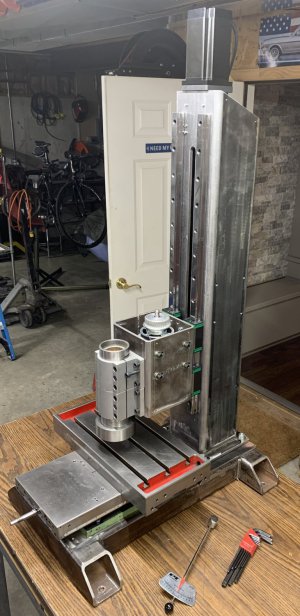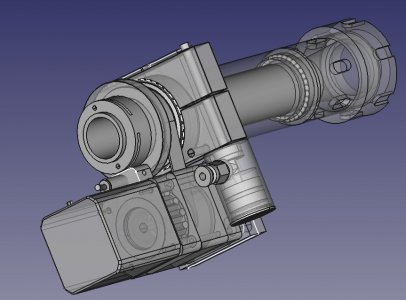I'm building my own CNC Mill and I'm looking for some advice/experience regarding the Z Axis. I'm using a Fehlmann (Swiss made) X-Y table with ball screw conversion, but I'm fabricating my own Z Axis Column with Linear Rails and a double nut ball screw. The NEMA 34 stepper motor is mount at the top. I'm on a budget so I'm using conventional stepper motors and digital drivers, some of which I have left over from other projects. Ultimately, I'd like to upgrade to closed loop servos.
The Z Axis motion is nice and smooth, but as expected it will drift down when not powered. So, my question is should I use a power off brake or a counterbalance. I know Teknics sells a NEMA 34 brake but it's for 1/2" shafts and my motor is a14mm shaft. Does anyone know of a source for similar brakes.
Any help would be appreciated.
Jim

The Z Axis motion is nice and smooth, but as expected it will drift down when not powered. So, my question is should I use a power off brake or a counterbalance. I know Teknics sells a NEMA 34 brake but it's for 1/2" shafts and my motor is a14mm shaft. Does anyone know of a source for similar brakes.
Any help would be appreciated.
Jim




![IMG_1017[1].JPG IMG_1017[1].JPG](https://www.hobby-machinist.com/data/attachments/400/400573-56d7560173080f49f1c50805b6172883.jpg)
![IMG_1016[1].JPG IMG_1016[1].JPG](https://www.hobby-machinist.com/data/attachments/400/400574-9b56241f2714134c9ca5cfd0f53a4e0a.jpg)
![IMG_1018[1].JPG IMG_1018[1].JPG](https://www.hobby-machinist.com/data/attachments/400/400575-903194fda91aa27d883be2b5391e5cc0.jpg)
![IMG_1019[1].JPG IMG_1019[1].JPG](https://www.hobby-machinist.com/data/attachments/400/400576-6058862378c4e81f122ad24a7f2b1a6c.jpg)
![IMG_1020[1].JPG IMG_1020[1].JPG](https://www.hobby-machinist.com/data/attachments/400/400577-5d1c23e47b488a19466bc79bab11389f.jpg)
![IMG_1023[1].JPG IMG_1023[1].JPG](https://www.hobby-machinist.com/data/attachments/400/400579-0df39ae60d22685fcd15504ed550ff1d.jpg)
